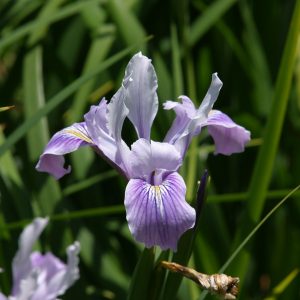
Douglas iris – Iris douglasiana
Range: Most extensive range of all PCI: a narrow coastal band extending 700 miles from the central Oregon coast to Santa Barbara, California.
Original collection: Monterey region, central California coast, by David Douglas.
Name: By Rev. George Herbert, 1840, after the naturalist David Douglas, who collected the original specimens.

Key identifying features:
- Stems often branched, each branch bearing 2-3 flowers
- Ovary / seed capsule triangular in cross section, with a nipple-like projection at end near floral tube
- Floral tube intermediate in length – ¾ to 1 inch long
- Leaves ¼ to 1 inch wide, shiny green above, dull green below, and evergreen
Flower color: Usually shades of light blue-violet to dark purple; occasionally white or yellow.
Habitat: Grows naturally along the coast, usually within sight of the ocean; common on bluffs and treeless grassy hillsides. It sometimes grows inland in areas where human activity has opened forests to abundant sunlight. Unpalatable to livestock; some ranchers consider it an aggressive weed.
Comments: This is a vigorous iris, common and widespread in coastal areas. It readily crosses with other PCI where ranges overlap.
When Douglas Iris is found farther inland, it is usually because it has crossed with other local iris species, better adapted to less exposed, shadier habitats. If you know the local iris species, you can often see evidence of this genetic mixing.
Some long established natural hybrid populations have been given their own names, like the colorful “Marin Iris” and “Santa Cruz Iris” (douglasiana × fernaldii × macrosiphon) in the Coastal Range just north and south, respectively, of San Francisco’s Golden Gate.
Douglas iris is widely used in the nursery trade, both as the species, and as a parent stock for many successful hybrids. In some way, it is involved in nearly all the named PCI horticultural varieties. Most are man-made hybrids—crosses from specially selected parents, but some are pure, wild plants grown because of certain outstanding features.
Several durable strains of pure Iris douglasiana include:
PCI ‘Amiguita’ – blue bi-tone with a purple signal spot
PCI ‘Canyon Snow – white with yellow eyespots
PCI ‘Harland Hand’ – purple, with a long blooming season
PCI ‘Mendocino Banner’ – white with purple veins and contrasting purple style crests.
